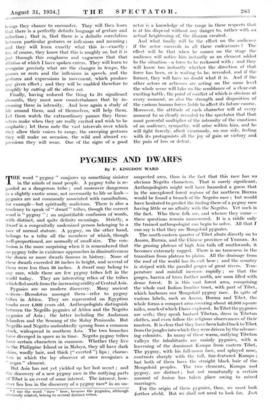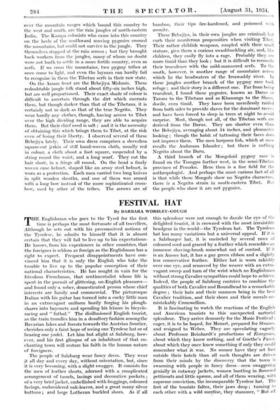PYGMIES AND DWARFS
By F. KINGDON WARD THE word " pygmy " conjures up something sinister in the minds of most people. A pygmy tribe is re- garded as a dangerous tribe ; and moreover dangerous in a slightly exotic sense, not necessarily to life or limb— pygmies are not commonly associated with cannibalism, for example—but spiritually malicious. There is also a tendency to speak of " dwarf " tribes, though the correct word is " pygmy " ; an unjustifiable confusion of words, with distinct, and quite definite meanings. Strictly, a dwarf is a congenitally undersized person belonging to a race of normal stature. A pygmy, on the other hand, belongs to a tribe all the members of which, though well-proportioned, are normally of small size. The con- fusion is the more surprising when it is remembered that no pygmy tribe in existence approaches in diminutiveness the dozen or more dwarfs famous in history. None of these dwarfs exceeded 36 inches in height, and several of them were less than 30 inches. A dwarf may belong to any race, while there are few pygmy tribes left in the world today. They are interesting relics of the tribes which fled south from the increasing aridity of Central Asia.
Pygmies are no modern discovery. Many ancient writers—Herodotus amongst them—refer to pygmy tribes in Africa. They are represented on Egyptian tombs over 4,000 years old. Anthropologists distinguish between the Negrillo pygmies of Africa and the Negrito pygmies . of Asia ; the latter including the Andaman Islanders and the Semang of the Malay Peninsula. But Negrillo and Negrito undoubtedly sprang from a common stock, widespread in southern Asia. The two branches have diverged in space as in time. Negrito pygmy tribes have certain characters in common. Whether they live in the Philippine Island or in Malaya, they all have dark skins, woolly hair, and thick (" everted ") lips ; charac- ters in which the lay observer at once recognizes a ,negrn " element.
But Asia has not yet yielded up her last secret ; and the discovery of a new pygmy race in the outlying parts Of Tibet is an event of some interest. The interest, how- ever lies less in the discovery of a pygmy race* in an un-
* I use the word " race " here, because the pygmies, although obviously related, belong to several distinct tribes.
suspected area, than in the fact that this race has no obvious Negrito characters. That is surely significant. Anthropologists might well have hazarded a guess that in the unexplored forest regions of far northern Burma would be found a branch of the Negrito race ; but would have hesitated to predict the finding there of a pygmy race having little or no affinity with the Negrito. Yet such is the fact. Who these folk arc, and whence they came— these questions remain unanswered. It is a riddle only the trained anthropologist can begin to solve. All that I can say is that they are Mongoloid pygmies.
The south-eastern quarter of Tibet abuts directly on to Assam, Burma, and the Chinese province of Yunnan. As the grazing plateau of high Asia tails off southwards, it becomes extremely rugged. There is no tameness in the transition from plateau to plains. All the drainage from the roof of the world has its exit here ; and the country is striped with the parallel gorges of great rivers. Tem- perature and rainfall increase rapidly ; so that the gorges, barren of trees further north, are soon filled with dense forest. It is this vast forest area, comprising the whole east Indian frontier tract, with part of Tibet, which harbours our Mongoloid pygmy race. In spite of various labels, such as Assam, Burma and Tibet, the whole forms a compact area covering about 40,000 square miles, much of which I have explored. In Tibet the pygmies are serfs ; they speak bastard Tibetan, dress in Tibetan clothes, and even follow the religious observances of their masters. It is clear that they have been haled back to Tibet from the jungles into which they were driven by the advanc- ing colonists. In many of these warm, outlying Tibetan valleys the inhabitants are mainly pygmies, with a leavening of the dominant Kampa from eastern Tibet. The pygmy, with his full-moon face, and splayed nose, contrasts sharply with the tall, fine-featured Kampa ; but both of them have the straight black hair of the Mongoloid peoples. The two elements, Kampa and pygmy, are distinct ; but not unnaturally a certain amount of fusion has taken place owing to mixed marriages.
For the origin of these pygmies, then, we must look further afield. But we shall not need to look far. Just over the mountain ranges which bound this country to the west and south, are the rain jungles of north-eastern India. The Kampa colonists who came into this country on the heels of the southward moving pygmies crossed the mountains, but could not survive in the jungle. They themselves stopped at the rain screen ; but they brought back workers from the jungles, many of whom no doubt were not loath to settle in a more fertile country, even as serfs. If we cross the mountains, two pygmy tribes at once come to light, and even the layman can hardly fail to recognize in them the Tibetan serfs in their raw state.
On the Assam front are the Bebejiya Mishmis. These redoubtable jungle folk stand about fifty-six inches high, but are well proportioned. Their exact shade of colour is difficult to ascertain through the dirt which encrusts them, but though darker than that of the Tibetans, it is certainly not so dark as that of the true Negrito. They wear hardly any clothes, though, having access to Tibet over the high dividing range, they are able to acquire them. But their chief need is salt ; and it is the necessity of obtaining this which brings them to Tibet, at the risk even of losing their liberty. I observed several of these Bebejiya lately. Their own dress comprises a sleeveless square-cut jerkin of stiff hand-woven cloth, usually red in colour, a cloth about a foot square, suspended by a string round the waist, and a long scarf. They cut the hair short, in a fringe all round. On the head a finely woven cane helmet, shaped like an army steel helmet, is worn as a protection. Each man carried two long knives in split wooden sheaths, and one of them was armed with a long bow instead of the more sophisticated cross- bow, used by other of the tribes. The arrows are of bamboo, their tips fire-hardened, and poisoned with aconite.
These Bebejiya, in their own jungles are criminal; but curb their murderous propensities when visiting Tibet. Their rather childish weapons, coupled with their small stature, give them a curious swashbuckling air, and, like children, they easily fly into a rage. Probably they are more timid than they look ; but it is difficult to reconcile their truculence with the mild-mannered serfs. To the south, however, is another range of mountains across which lie the headwaters of the Irrawaddy river. In these jungles another branch of the pygmy race took refuge ; and their story is a different one. Far from being truculent, I found these pygmies, known as Darus or Tarons to the Tibetans and as Khanungs to the Shans, docile, even timid. They have been mercilessly raided from both sides to provide slaves for the dominant races ; and have been forced to sleep in trees at night to avoid surprise. Most, though not all, of the Tibetan serfs are derived from the Darus. They are shorter even than the Bebejiya, averaging about 54 inches, and pleasanter looking ; though the habit of tattooing their faces does not. improve them. The men harpoon fish, which at once recalls the Andaman Islander ; but there is nothing Negrito about the Daru.
A third branch of the Mongoloid pygmy race is found on the Tsangpo further west, in the semi-Tibetan province of Pcmako. Here then is a fine field for the anthropologist. And perhaps the most curious fact of all is that while these Mongols show no Negrito characters, there is a Negrito strain in south-eastern Tibet. But the people who show it are not pygmies.







































 Previous page
Previous page